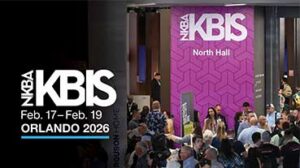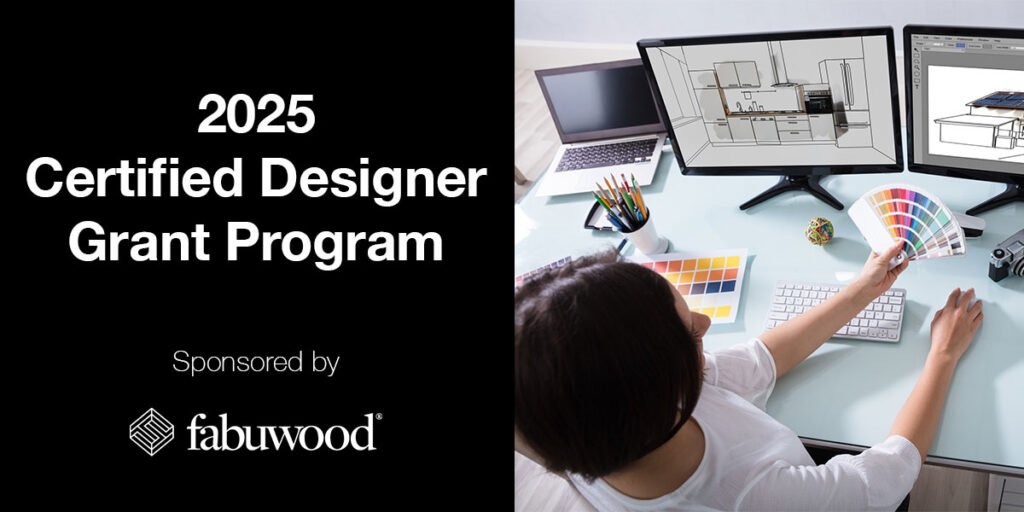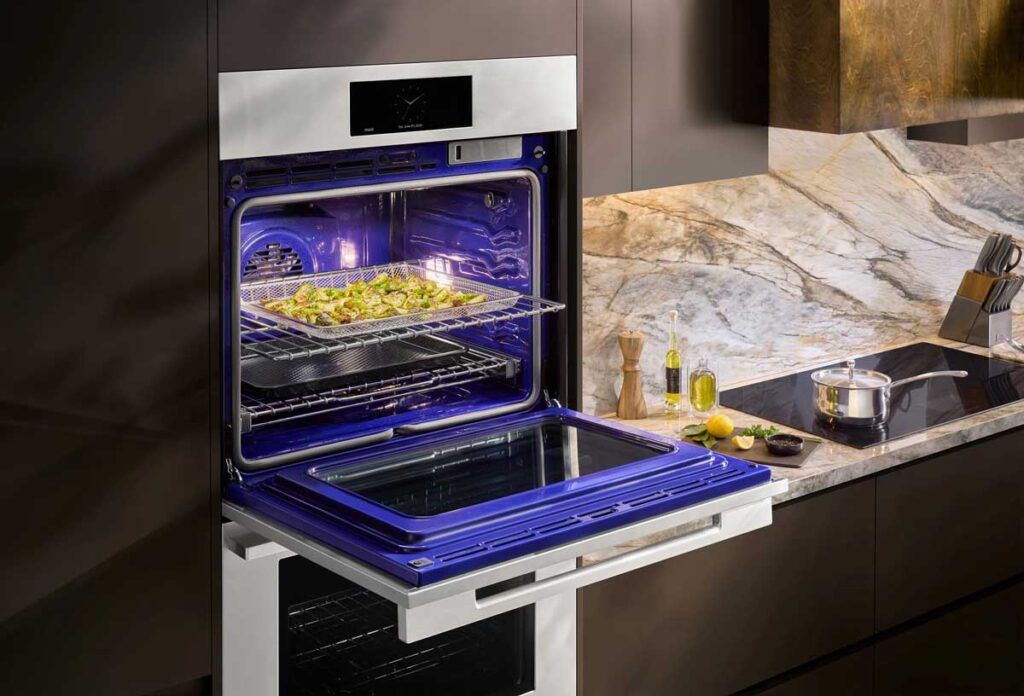NKBA’s micro-credential program adds its ninth discipline.

By Dianne M. Pogoda
NKBA’s highly successful Specialty Badge program has added a new discipline: Appliance Specialist.
The program launched at KBIS 2019 with five badges and added three more in the interim. The Appliance Specialist is the ninth badge, joining Sales & Marketing, Floor Plans & Specifications, Color, Sustainability, Cabinetry, Remodeling, Lighting, and Universal Design. While NKBA’s industry-leading CKBD and CMKBD certifications are centered on designers, the badges may be earned by members in any sector of the industry, including designers, remodelers, manufacturers, dealers, educators, and skilled tradespeople. As an all-industry association, it’s part of NKBA’s ongoing mission to provide educational opportunities for all members at any stage of their professional development.
Requirements and testing for Specialty Badges are developed by NKBA’s Learning Department in conjunction with Subject Matter Experts in the particular discipline, following the NKBA’s 4th Edition K&B Planning Guidelines, building policies, access codes, and standards. For the Appliance Badge, NKBA gratefully acknowledges the time, expertise and insights from four industry professionals: Jared Costa, Director of National Sales & Product Training for Miele; Jonathan Barfell, currently Marketing Director at Schréder USA and previously Marketing Director at Liebherr Appliances; Heather Guerriero Dans, currently a consultant for Tulip Cooking modular burners and previously of GE’s Monogram luxury division, and independent consultant Paula Smith, AKBD, a veteran of GE and Fisher & Paykel in product management, showroom operations, and marketing.
Over the course of several months, the committee created the content and developed exam questions. Among the most critical points of the Appliance Badge, the experts concurred, is client assessment.
Barfell said the most important element is learning the right questions to ask the client. “Appliance options are endless, and knowing some specific solutions that help your clients’ needs saves them both time and money,” he said.
“We wanted to equip [badge holders] with the most important information relevant to appliances,” Dans recalled. “For instance, how do they cook? What kind of oven or burners do they need? Speed cooking, microwave, convection, induction, level of BTUs — it’s great for designers to be able to discuss the specifics to get the right products for their clients.”
Smith noted that two key elements of the badge include “a deep understanding of the various appliance options — styles, configurations, and feature sets — and how these can be selected to meet both aesthetic and lifestyle needs,” as well as “a working knowledge of the technology behind different appliance categories and the performance benefits of various appliances, helping professionals guide their clients with confidence.”
The appliance badge highlights the evolution of appliances with emphasis placed on product selection, categories, models, sizes, configurations, and installation methods for both indoor and outdoor spaces. An overview of product mechanics, cooking technologies and proper ventilation is central to the discussion, along with price and budget comparisons, client interaction, and evaluation.
Costa concurred, “The assessment of a client’s needs and preferences creates differentiation and elevates the level of service being provided. Next, simply gaining knowledge of the appliances [allows you to] apply that knowledge to the assessment. This is crucial to providing each client with an individual approach. The most well-informed professionals will inherently guide a client with thoughtful planning and an understanding of how to make the most of their space.”
To earn the badge, candidates must complete five learning objectives, demonstrating competency and knowledge of the following:
• Different product categories and options within cooking, cooling, ventilation, and cleaning.
• Appliance placement within the principles of kitchen and home design.
• Cooking technologies, effectiveness, functionality, and ventilation requirements.
• How to effectively specify appliances based on the client’s needs.
• Outdoor kitchen appliances and space planning.
“The technology changes pretty quickly, and designers may not necessarily stay on top of all the latest developments,” said Dans, noting that the badge prep helps keep them up to date and understand these advancements. “Especially at the high end, it’s beneficial to the client for the designer to take them shopping for appliances so they can consider everything that’s available.”
Badge candidates must also show their knowledge of energy efficiency, including the EnergyGuide label and the U.S. EPA’s Energy Star label, the impact of various cooking appliances on indoor air quality, water filtration, food preservation, different types of heat transference in various cooking processes, code compliance, work zone clearances, and other mechanical, technical, and layout considerations.
“The significance of the badges can’t be stressed enough,” Costa observed. “In this age, information is everywhere. However, useful information can be hard to recognize. The NKBA Specialty Badge Program is a testimony to members that the organization provides support and service that has relevant benefits and true value. For the badge holder, they have an ability to demonstrate and communicate their expertise in an objective manner.”
The program is self-directed and fully online, where study material and exams are accessible at any time, for the convenience of the participant.
The Specialty Badge Program allows members to broaden their toolkit, expand their industry knowledge, and stay current with the latest technologies. It’s also considered a beneficial stepping-stone for members who are interested in becoming certified.
“The program equips industry professionals with targeted knowledge that enhances their expertise,” said Smith, “whether they are building on foundational skills or advancing their understanding of a specialized area.”
Barfell added, “If you are just starting out in the industry, understanding types of appliances and installation methods are critical. As a well-established player, understanding the most recent advancements in technology complements what you already know.”
After earning a badge, recipients may showcase their credential by displaying a digital badge image across several platforms, and they also receive a certificate of completion and lapel pin.
“There is a certain expectation that comes with being associated with the NKBA,” said Costa. “The industry deems members as informed and competent… as leaders who constantly seek to have and provide up-to-date information. The NKBA’s Specialty Badge Program is a vital part of this. It is a means of ensuring that members can deliver those expectations and even surpass them. When a kitchen is designed with a complete perspective and all of the information available, the entire industry benefits.”
Barfell pointed out, “As someone who has spent over 10 years educating in the appliance space, I am still learning each day. Technologies are changing so fast, and it might seem daunting to try and keep up. Thankfully, the Specialty Badge offers a very solid foundation on one of the largest kitchen investments your client will have.”
Smith concluded that this industry is always evolving, so ongoing learning is essential. “The NKBA’s Specialty Badge Program offers both newcomers and veterans a valuable way to continue building their expertise,” she said. “The Specialty Bade program provides an opportunity to enhance members’ skill set in complementary areas, further enriching the overall strength of the kitchen and bath industry.”






















